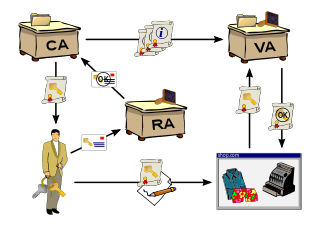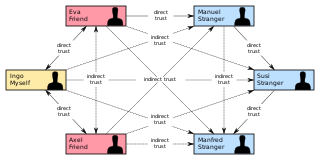Related Research Articles

In cryptography, encryption is the process of encoding information. This process converts the original representation of the information, known as plaintext, into an alternative form known as ciphertext. Ideally, only authorized parties can decipher a ciphertext back to plaintext and access the original information. Encryption does not itself prevent interference but denies the intelligible content to a would-be interceptor.

Public-key cryptography, or asymmetric cryptography, is a cryptographic system that uses pairs of keys. Each pair consists of a public key and a private key. The generation of such key pairs depends on cryptographic algorithms which are based on mathematical problems termed one-way functions. Effective security requires keeping the private key private; the public key can be openly distributed without compromising security.

A digital signature is a mathematical scheme for verifying the authenticity of digital messages or documents. A valid digital signature, where the prerequisites are satisfied, gives a recipient very strong reason to believe that the message was created by a known sender (authentication), and that the message was not altered in transit (integrity).
Cryptomathic is a software company specializing in the area of cryptography for e-commerce security systems. The company develops secure software for the financial and governmental industries. It focuses especially on developing back-end solutions using hardware security modules.

A public key infrastructure (PKI) is a set of roles, policies, hardware, software and procedures needed to create, manage, distribute, use, store and revoke digital certificates and manage public-key encryption. The purpose of a PKI is to facilitate the secure electronic transfer of information for a range of network activities such as e-commerce, internet banking and confidential email. It is required for activities where simple passwords are an inadequate authentication method and more rigorous proof is required to confirm the identity of the parties involved in the communication and to validate the information being transferred.

David Chaum is an American computer scientist and cryptographer. He is known as a pioneer in cryptography and privacy-preserving technologies, and widely recognized as the inventor of digital cash. His 1982 dissertation "Computer Systems Established, Maintained, and Trusted by Mutually Suspicious Groups" is the first known proposal for a blockchain protocol. Complete with the code to implement the protocol, Chaum's dissertation proposed all but one element of the blockchain later detailed in the Bitcoin whitepaper.
Online Business or e-business is any kind of business or commercial transaction that includes sharing information across the internet. Commerce constitutes the exchange of products and services between businesses, groups, and individuals and can be seen as one of the essential activities of any business. Electronic commerce focuses on the use of information and communication technology to enable the external activities and relationships of the business with individuals, groups, and other businesses, while e-business refers to business with help of the internet. Electronic business differs from electronic commerce as it does not only deal with online transactions of selling and buying of a product and/or service but also enables to conduct of business processes within the value chain through internal or external networks. The term "e-business" was coined by IBM's marketing and Internet team in 1996.
An electronic signature, or e-signature, is data that is logically associated with other data and which is used by the signatory to sign the associated data. This type of signature has the same legal standing as a handwritten signature as long as it adheres to the requirements of the specific regulation under which it was created.
Latent semantic analysis (LSA) is a technique in natural language processing, in particular distributional semantics, of analyzing relationships between a set of documents and the terms they contain by producing a set of concepts related to the documents and terms. LSA assumes that words that are close in meaning will occur in similar pieces of text. A matrix containing word counts per document is constructed from a large piece of text and a mathematical technique called singular value decomposition (SVD) is used to reduce the number of rows while preserving the similarity structure among columns. Documents are then compared by taking the cosine of the angle between the two vectors formed by any two columns. Values close to 1 represent very similar documents while values close to 0 represent very dissimilar documents.
XML Signature defines an XML syntax for digital signatures and is defined in the W3C recommendation XML Signature Syntax and Processing. Functionally, it has much in common with PKCS #7 but is more extensible and geared towards signing XML documents. It is used by various Web technologies such as SOAP, SAML, and others.

In psychology and sociology, a trust metric is a measurement or metric of the degree to which one social actor trusts another social actor. Trust metrics may be abstracted in a manner that can be implemented on computers, making them of interest for the study and engineering of virtual communities, such as Friendster and LiveJournal.
A Byzantine fault is a condition of a computer system, particularly distributed computing systems, where components may fail and there is imperfect information on whether a component has failed. The term takes its name from an allegory, the "Byzantine Generals Problem", developed to describe a situation in which, in order to avoid catastrophic failure of the system, the system's actors must agree on a concerted strategy, but some of these actors are unreliable.

A digital watermark is a kind of marker covertly embedded in a noise-tolerant signal such as audio, video or image data. It is typically used to identify ownership of the copyright of such signal. "Watermarking" is the process of hiding digital information in a carrier signal; the hidden information should, but does not need to, contain a relation to the carrier signal. Digital watermarks may be used to verify the authenticity or integrity of the carrier signal or to show the identity of its owners. It is prominently used for tracing copyright infringements and for banknote authentication.
Distributed key generation (DKG) is a cryptographic process in which multiple parties contribute to the calculation of a shared public and private key set. Unlike most public key encryption models, distributed key generation does not rely on Trusted Third Parties. Instead, the participation of a threshold of honest parties determines whether a key pair can be computed successfully. Distributed key generation prevents single parties from having access to a private key. The involvement of many parties requires Distributed key generation to ensure secrecy in the presence of malicious contributions to the key calculation.
Trusted timestamping is the process of securely keeping track of the creation and modification time of a document. Security here means that no one—not even the owner of the document—should be able to change it once it has been recorded provided that the timestamper's integrity is never compromised.
Direct Anonymous Attestation (DAA) is a cryptographic primitive which enables remote authentication of a trusted computer whilst preserving privacy of the platform's user. The protocol has been adopted by the Trusted Computing Group (TCG) in the latest version of its Trusted Platform Module (TPM) specification to address privacy concerns. ISO/IEC 20008 specifies DAA, as well, and Intel's Enhanced Privacy ID (EPID) 2.0 implementation for microprocessors is available for licensing RAND-Z along with an open source SDK.

Cryptography, or cryptology, is the practice and study of techniques for secure communication in the presence of adversarial behavior. More generally, cryptography is about constructing and analyzing protocols that prevent third parties or the public from reading private messages; various aspects in information security such as data confidentiality, data integrity, authentication, and non-repudiation are central to modern cryptography. Modern cryptography exists at the intersection of the disciplines of mathematics, computer science, electrical engineering, communication science, and physics. Applications of cryptography include electronic commerce, chip-based payment cards, digital currencies, computer passwords, and military communications.
In natural language processing and information retrieval, explicit semantic analysis (ESA) is a vectoral representation of text that uses a document corpus as a knowledge base. Specifically, in ESA, a word is represented as a column vector in the tf–idf matrix of the text corpus and a document is represented as the centroid of the vectors representing its words. Typically, the text corpus is English Wikipedia, though other corpora including the Open Directory Project have been used.

Peter Landrock is a Danish cryptographer and mathematician. He is known for his contributions to data encryption methods and codes. Landrock has been active since the 1970s as research scientist and faculty member for Cambridge University and the University of Aarhus and others, and was active for Microsoft and Cryptomathic. He has been visiting professor at Oxford University, Leuven University and Princeton University.
The Ricardian contract, as invented by Ian Grigg in 1996, is a method of recording a document as a contract at law, and linking it securely to other systems, such as accounting, for the contract as an issuance of value. It is robust through use of identification by cryptographic hash function, transparent through use of readable text for legal prose and efficient through markup language to extract essential information.
References
- 1 2 P. Landrock, T. Pedersen, "WYSIWYS? -- What you see is what you sign?". Information Security Technical Report, Volume 3, Number 2, 1998, pp. 55-61
- 1 2 A. Jøsang and B. AlFayyadh. "Robust WYSIWYS: A Method For Ensuring that What You See Is What You Sign". Proceedings of the Australasian Information Security Conference (AISC'08), Wollongong, Australia, January 2008.
- ↑ A. Weber, "See What You Sign: Secure Implementations of Digital Signatures", in Proceedings of the International Conference on Intelligence and Services in Networks, 1998, pp. 509-520.
- ↑ K. Scheibelhoferm, "Signing XML Documents and the Concept of What You See Is What You Sign", Masters thesis, Graz University of Technology, Austria, 2001.
- ↑ A. Spalka, A.B. Cremers, H. Langweg, "The fairy tale of What You See Is What You Sign - Trojan Horse Attacks on Software for Digital Signatures", in IFIP Working Conference on Security and Control of IT in Society-II (SCITS-II).
- ↑ A. Jøsang, D. Povey and A. Ho. "What You See is Not Always What You Sign". Proceedings of the Australian Unix User Group Symposium (AUUG2002), Melbourne, September, 2002.
- ↑ A. Alsaid, C. Mitchell, "Dynamic Content attacks on Digital Signatures", Information Management and Computer Security 13(4), 2005, pp.328-336.